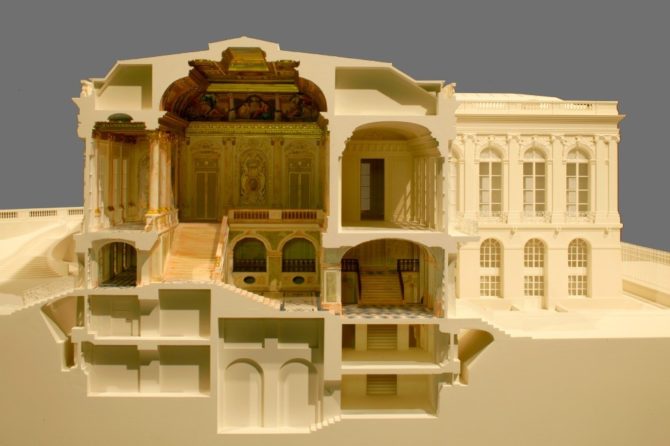L’Hôtel Particulier, Une Ambition Parisienne

Private Parisian mansions, among the city’s most emblematic architectural treasures, are celebrated by an exceptional exhibition, L’Hôtel Particulier, Une Ambition Parisienne, at the Cité de l’Architecture & du Patrimoine.“Having your own townhouse was like putting up a sign advertising your success,” contends the show’s curator, art historian Alexandre Gady. Aristocrats and financiers vied to build the most impressive demeures and throw the grand soirées that contributed to the city’s effervescent reputation.
The show’s clever mise en scène, bolstered by photographs, furnishings and paintings, documents the characteristics of these extraordinary mansions from the medieval Hôtel de Cluny to the Belle Epoque Palais Rose. Beginning with the cobblestoned courtyard that separated the house from its walled entrance on the street to the private greenery symbolized by a trellised garden, visitors walk through an enfilade of rooms that represents the requisite layout of these elite residences.
The vestibule and antechambers gave onto grand sweeping staircases with ironwork banisters that led to magnificent reception rooms ablaze with opulent furniture and decorative details: sculpted cornices, parquet floors, gilded doors and intricate paneling. Here antique marble mantels, sconces by 18th-century sculptor Pierre Gouthière and a c.1785 tric-trac (backgammon) table in oak, mahogany and ormolu evoke the ambiance in the Salon Louis XVI.
In contrast, a glimpse of a behind-the-scenes private corridor demonstrates the march of sanitary progress with an elegant wooden lavatory chair. In another section, fabulous scale models provide an insight into princely proportions. The Hôtel Lambert, another 17th-century masterwork by Versailles architect Louis Le Vau, hosted Guy and Marie-Hélène de Rothschild’s memorable late 20th-century balls. The 18th-century Hôtel de Thélusson, whose owner, a Swiss banker’s widow, had requested a “modest” retreat, found herself instead with architect Claude-Nicolas Ledoux’s grandiose showplace—later destroyed to make way for the rue Lafayette.
Inspired by Marie Antoinette’s Petit Trianon, aristocratic dandy Count Boni de Castellane dreamt up the Palais Rose, on the avenue Foch, built between 1896 and 1902 by architect Ernest Sanson. A cut-away model reveals the regal interior, including a staircase modeled on that of the Les Ambassadeurs stairway at Versailles. Footing the bill for the pink marble Belle Epoque extravaganza was de Castellane’s wife, Anna, daughter of American rail magnate and robber baron Jay Gould. The house survived their divorce, but was demolished in 1969 to be replaced by a banal apartment building. Fortunately, some 500 Parisian hôtels particuliers still exist, many of them now museums, including the Musée Jacquemart-André, the Musée Nissim de Camondo and the Rodin museum, in the 18th-century Hôtel de Biron. Others are still inhabited by the fortunate families who own them.
Through Feb 19. Palais de Chaillot, 1 pl du Trocadéro, 16th, www.citechaillot.fr
Originally published in the December 2011 issue of France Today
Share to: Facebook Twitter LinkedIn Email
Leave a reply
Your email address will not be published. Required fields are marked *



